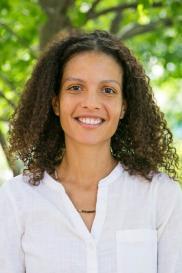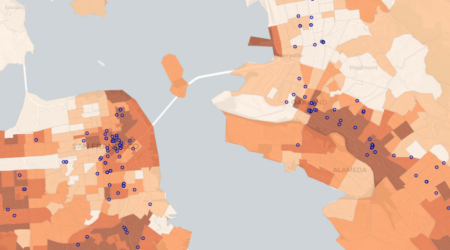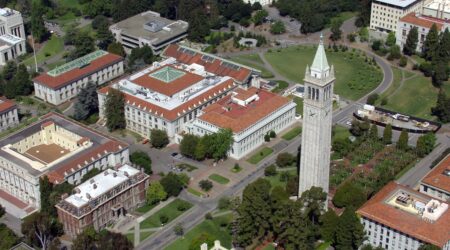A recent panel discussion, “Understanding and seeking equity amid COVID-19” — presented as part of the Berkeley Conversation: COVID-19 series — focused on the disproportionate impacts of COVID-19 on marginalized communities, particularly racial and ethnic minorities. The Center for Disease Control has confirmed that “data suggest a disproportionate burden of illness and death among racial and ethnic minority groups,” and the Pew Research Center has released research showing a wide gap in financial and health impacts of COVID-19 among different demographic groups.
 Facilitated by Jennifer Chayes, Associate Provost of the Division of Computing, Data Science, and Society, and Dean of the School of Information, the Berkeley Conversation panel brought together faculty from diverse disciplines to examine the structural challenges that have shaped the inequitable impacts on minorities, as well as issues like algorithmic bias and dissemination of misinformation.
Facilitated by Jennifer Chayes, Associate Provost of the Division of Computing, Data Science, and Society, and Dean of the School of Information, the Berkeley Conversation panel brought together faculty from diverse disciplines to examine the structural challenges that have shaped the inequitable impacts on minorities, as well as issues like algorithmic bias and dissemination of misinformation.
Ziad Obermeyer, Acting Associate Professor of Health Policy and Management at Berkeley Public Health, noted that algorithms intended to help healthcare professionals predict which populations will likely get sick in the near-future were directed toward white patients twice as much in comparison to people of color. The reason: one of the variables input into the algorithm, “healthcare cost,” failed to capture marginalized populations who have less access to healthcare, and thereby classified these communities as not needing health services. Obermeyer warned of potential pitfalls in testing data for COVID-19, and suggested incorporating social-science methods (such as population-based surveys) to complement other datasets used to prepare and allocate health resources.
Niloufar Salehi, Assistant Professor at the School of Information at UC, Berkeley, talked about how different communities use social networks and social media, and how data perpetuates disparities. She highlighted that, because information on COVID-19 is exchanged through encrypted and closed channels and messaging apps, it is hard to track the proliferation of potential misinformation. She advised researchers and practitioners to challenge datasets by questioning where data is looked for and what is omitted.
 Sarah Vaughn, Assistant Professor of Anthropology, discussed how qualitative research can complement other datasets and help promote greater understanding of social and cultural context. She highlighted that, by understanding how data and technology is produced and consumed on the ground, we can better understand how technologies shape the identity and narratives of different communities.
Sarah Vaughn, Assistant Professor of Anthropology, discussed how qualitative research can complement other datasets and help promote greater understanding of social and cultural context. She highlighted that, by understanding how data and technology is produced and consumed on the ground, we can better understand how technologies shape the identity and narratives of different communities.
We reached out to Professor Vaughn to delve deeper into these questions, and how the lessons learned from previous research can apply to the COVID-19 crisis. (Note: this interview has been edited for clarity.)
In the Berkeley Conversation, you talked about how ethnography allows us to think across cultures. From your experience, how do communities respond to issues such as disaster preparedness?
I work in Global South contexts, particularly the Caribbean, which is a part of the world with countries that are relatively small in size and number. Scale is important in terms of contextualizing what a disaster is and what it means to prepare for them. I have done research in Guyana on disastrous flooding and climate adaptation measures. When disastrous flooding happens in Guyana, the majority of the population is affected in some way, and people expect a response from the government on a national, not a local level.
This perspective is quite different from how Americans tend to imagine who is impacted by a disaster. For example, in the case of Hurricane Katrina, many Americans took a shortsighted perspective by only recognizing the event as affecting “marginalized” groups, particularly poor and black communities in Louisiana and Mississippi. Now compare Katrina with what we are experiencing with COVID-19. The events unfolding around COVID-19 are adversely impacting poor and black communities, but this is happening at the same time that the entire United States is being directly impacted by the virus. So, some Americans have now begun to ask: Isn’t every American vulnerable to disaster? If so, then should I expect to be taken care of by federal authorities when a disaster strikes? If not, then how do I ensure that local authorities figure out how to prepare? How do I respond to neighbors, family, coworkers, or authorities who do not take appropriate measures to protect my health and livelihood? In other words, there’s a need for more social science research that takes into account political discourses about disaster and scale.
Based on your research in the Caribbean, what lessons can we learn about the role that qualitative research plays in complementing and even challenging quantitative approaches to researching disasters and pandemics?
I think it might be helpful to answer this question in more general terms. Demographics, for instance, cannot tell you the whole story about how a disaster affects people. A social scientist may have robust methods such as surveys, that help him/her identify the racial or gender demographics of a given vulnerable population. But these demographics do not necessarily explain the broader social context that contributed to the disaster. In this respect, ethnography is a crucial method in qualitative research, because it can provide a perspective on the day-to-day or “ordinary” experiences of vulnerable populations, as well as the experts who attempt to care and respond to them overtime. Anthropologists of very different intellectual leanings—including Veena Das, Peter Redfield, and Kathleen Stewart—all make this point clear. Their ethnographies detail how people create social connections (and sometimes even become cut-off from each other) as they struggle to identify, live through, and make sense of catastrophe.
Can you expand on the role of technology in disseminating information and shaping identities within communities?
Social scientists need to better understand how people use technologies when critical infrastructures are absent or fail them during a disaster. In my research on climate adaptation, I have noticed that people are becoming more dependent on technologies that are easily assembled and have the “user’s immediate needs in mind.” For instance, following the consultation of humanitarian organizations such as the Red Cross, communities in Guyana have invested in developing water filtration kits to cope with flood hazards. As communities in Guyana have become more self-sufficient in responding to flooding, the government has taken note. While it has invested in a national flood early-warning system, it also expects communities to create their own version of a “neighborhood flood watch,” whereby people call or leave social media posts for each other to share information about flood hazards.
Social scientists need to better understand how people use technologies when critical infrastructures are absent or fail them during a disaster.
This re-distribution of responsibility between the government and public may prove efficient, but it does raise a number of questions. What entails a model for technological design when the environments people live in are prone to ruin and destruction? To what extent do technologies that are easily assembled and mobile undermine or uphold the notion of a social contract? In posing these questions, I want to be very cautious and say that the technological arrangements between the government and communities in Guyana are not solely contingent on political-economic ideologies of self-sufficiency. Instead, what is really at stake is how people design technologies in ways that are influenced by their lived experiences of vulnerability.
In this respect, I think that we can expand our conversation on disaster and technology to consider the debates about COVID-19 and the role of the government and private sector in their plans to disseminate at-home testing kits. The immediate issue in this context becomes: How do people use at-home testing kits in order to live through different stages of the pandemic? How do the at-home testing kits shape their understanding of vulnerability and social distancing through the pandemic?
How can this help address the larger issue of seeking equity in the context of disasters and pandemics?
We have to remember that equity means different things to different people. There isn’t one model for equity. But if I had to define equity in a succinct way, I would say that it involves considering people’s varying interests and desires in order to achieve fairness. Again, this is why I think that ethnographic research on disaster that is critical of technology and its potential to support vulnerable populations is important. Perhaps the first thing many of us recognize when we are immediately impacted by a disaster is that our basic needs cannot be met, or at least not in a reasonably well-organized fashion. Paying attention to how technologies fail or even support daily life during a disaster provides a perspective on people’s sense of equity and perhaps what types of aid and resources they think they deserve to get back to normal.
Image: Data from the New York City Department of Health and Mental Hygiene (NYC Health). Data are derived from the Bureau of Communicable Disease Surveillance System as of April 16, 2020.


